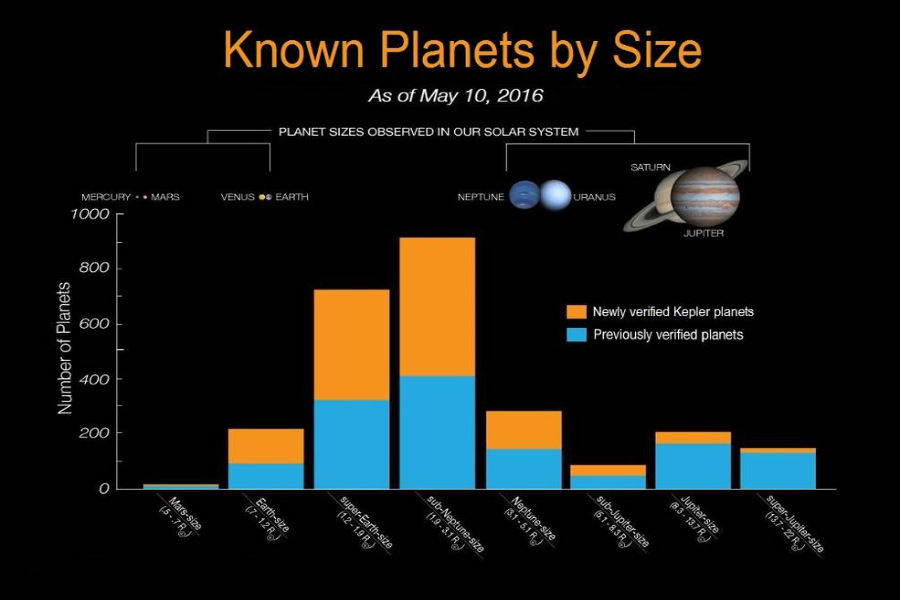Kepler has spotted 1,284 new exoplanets, thanks to new verification method
Loading...
In one sweep, scientists have verified 1,284 new planets that were discovered by NASA's planet-hunting telescope Kepler, thanks to a new statistical analysis technique developed at Princeton University.
This doubles the number of exoplanets, or planets orbiting their own stars outside of our solar system, that Kepler has discovered since it was first launched in 2009.
"Before the Kepler space telescope launched, we did not know whether exoplanets were rare or common in the galaxy," Paul Hertz, the astrophysics division director at NASA, said in a statement. "Thanks to Kepler and the research community, we now know there could be more planets than stars."
The researchers conducted the computer analysis on the 4,302 potential planets that Kepler had identified by the end of its first mission in 2013. Kepler identifies planets by searching for transits, the tiny dips in the brightness of stars as planets crosses in front them.
Until now, those potential planets have been verified by ground-based measurements to ensure that what the telescope saw is actually a planet and not what astronomers call an "imposter." An imposter could be another object, such as a small star, that appears to be a planet passing across the larger star, or two stars in orbit around each other in what's called a binary star pair, passing in front of a larger star and thus dimming the light Kepler observes.
The problem is that manually verifying planets takes a really long time.
"The process of verifying planets has involved detailed studies, done on a case-by-case basis," Timothy Morton, associate research scholar at Princeton University and the creator of the new analysis system, said in a media briefing. "One of the biggest challenges is that these methods are time– and resource-intensive," he said.
Dr. Morton is the lead author of a paper on the topic published in The Astrophysical Journal. His method is based on previous ones, where an analysis would take into account existing knowledge of how common binary stars are, for instance, to rule them out among the heaps of data from Kepler. But unlike earlier techniques, Morton's computation method is fully automated, spending only a few minutes on each planetary candidate, he says.
"A good analogy is to imagine planet candidates as bread crumbs," said Morton during the press briefing. "If you drop a few large crumbs on the floor, you can pick them up one by one. But, if you spill a whole bucket of tiny crumbs, you're going to need a broom. This statistical analysis is our broom," he said.
For the 1,284 planets recently deemed real, Morton’s team determined that the probability of each one being a planet is greater than 99 percent, the minimum required. Another 1,327 of Kepler's candidates are likely planets, but don't meet the 99 percent criterion and need additional study, says NASA. That leaves 707 as likely to be some other astrophysical phenomena.
In the batch of validated planets announced Tuesday, nearly 550 could be rocky planets like Earth, based on their size, reported NASA. Nine of these orbit in the habitable zone of their sun, or star: the perfect distance between a planet and its star to allow the planet's surface temperature to host liquid water, believed to be a prerequisite for life. Astronomers now know of 21 exoplanets less than twice the size of Earth that have some of the conditions for life.
Next astronomers will study these planets' atmospheres for signs of life by using the Hubble Space Telescope, a 26-year-old spacecraft exploring the cosmos, and the James Webb Space Telescope, Hubble's successor, which is due to launch in 2018.
Kepler, which has monitored 150,000 stars in a single patch of sky to seek out habitable planets, will likely run out of fuel in summer 2018, according to Charlie Sobeck, Kepler mission manager at NASA's Ames Research Center. This won't impact NASA's planet-hunting missions, though, as Kepler's successor, the Transiting Exoplanet Survey Satellite, will use the same technique to monitor 200,000 bright stars nearby on a search for planets near the size of ours.
Of the nearly 5,000 total planet candidates found to date, more than 3,200 now have been verified, and 2,325 of these were discovered by Kepler, says NASA.








